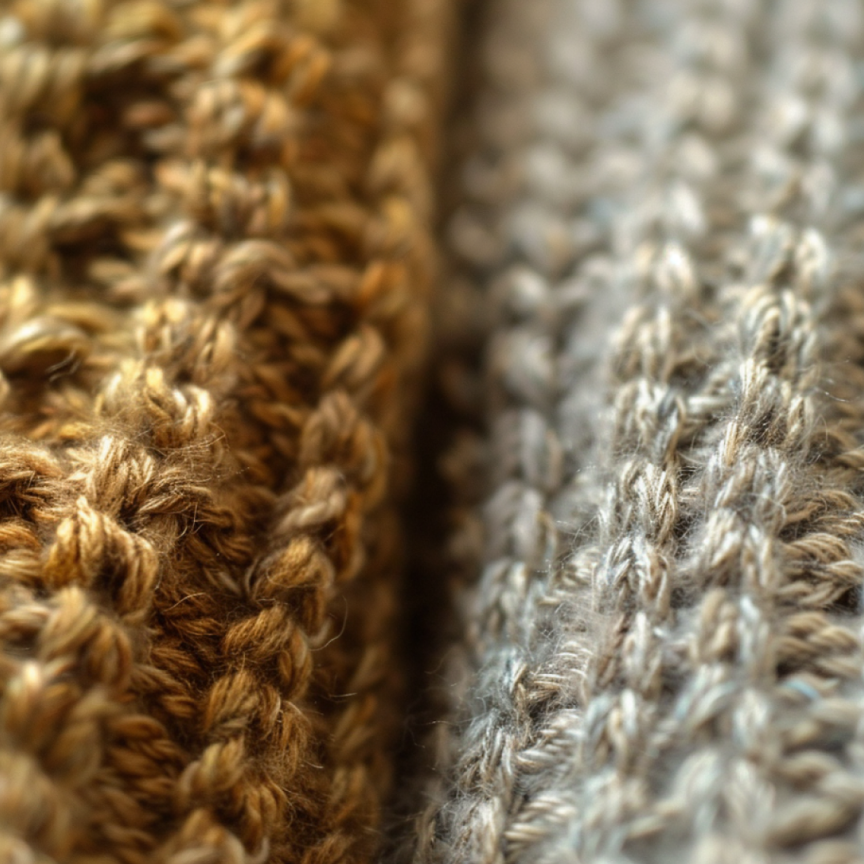In the intricate tapestry of fabrics, the distinction between knit and woven fabrics holds the key to understanding the diverse landscapes of textiles. These two weaving techniques not only shape the physical characteristics of fabrics but also play a pivotal role in the realm of garment repair, reweaving, and the specialized craft of knitwear repair.
The Woven Elegance
Woven fabrics, characterized by their structured and interlaced yarns, embody a timeless elegance. The weaving process involves perpendicular yarns – the warp and weft – intertwining to create a stable and often more rigid fabric. This meticulous interlacing results in a cohesive and visually distinctive pattern.
Woven fabrics, with their inherent stability, are commonly found in garments that require structure and form. Think of the crispness of a tailored suit or the structured silhouette of a button-down shirt – these are manifestations of the artful interplay of warp and weft.
In the realm of garment repair, woven fabrics present a unique set of challenges and opportunities. Repairs often involve maintaining the integrity of the original weave, seamlessly blending new threads into the existing structure. The intricacies of reweaving on woven fabrics demand a skilled artisan’s touch, as each thread must align with the established pattern to preserve the garment’s visual and tactile continuity.
Knit: A Symphony of Loops
On the other side of the textile spectrum, knit fabrics dance to a different rhythm. Knitting involves creating loops of yarn, interconnected like a series of interlocking stitches. This results in a more flexible, stretchable, and often softer fabric with a distinctive texture.
Knit fabrics are renowned for their comfort and versatility. From the cozy embrace of a knit sweater to the effortless drape of a jersey dress, the fluidity of knits allows for ease of movement and a snug fit. The inherent elasticity of knit fabrics makes them suitable for garments that require stretch and recovery, adapting seamlessly to body contours.
When it comes to repairing knit fabrics, the dynamic nature of loops introduces a nuanced challenge. Knitwear repair transcends conventional stitching; it involves delicately recreating the interconnected loops to mend holes or tears. The precision required in knitwear repair is akin to orchestrating a symphony of loops, ensuring that each new stitch seamlessly integrates with the existing fabric, preserving both form and function.
Garment Repair: A Unifying Thread
In the intricate dance between woven and knit fabrics, garment repair emerges as the unifying thread that binds these textile realms. Whether dealing with the meticulous reweaving of a tailored jacket or the intricate repair of a cherished knit sweater, the essence of garment repair lies in the artful restoration of textiles.
The skilled artisans who specialize in garment repair navigate the unique challenges posed by woven and knit fabrics. For woven fabrics, the repair process involves a harmonious integration of new threads, carefully interlaced to mimic the original pattern. On the knit front, repairs delve into the realm of loops and stitches, delicately recreating the fabric’s texture and elasticity.
Beyond the technical aspects, garment repair is a narrative of preservation. It’s about breathing new life into beloved garments, extending their journey and resonating with the ethos of sustainability. By choosing repair over replacement, individuals contribute to a textile narrative that values the longevity of fabrics and the stories woven into each garment.
The Art of Reweaving: Bridging Textile Realms
Within the expansive world of garment repair, the art of reweaving stands as a bridge between woven and knit fabrics. Reweaving is a meticulous craft that transcends the constraints of fabric type, offering a solution for garments of diverse textures and weaves.
In woven fabrics, the reweaving process involves an intricate dance of warp and weft, recreating the structured pattern seamlessly. It’s a symphony of threads that requires precision and expertise to ensure that the repaired area seamlessly integrates with the rest of the fabric.
In the realm of knitwear, reweaving becomes a dance of loops and stitches. Repairing a hole in a knit garment involves recreating the interconnected loops, blending the repair seamlessly into the fabric’s dynamic texture. The artful hands of a reweaving specialist navigate the intricate landscape of knits, preserving the garment’s original allure.
Textile Preservation: A Sustainable Legacy
As the textile narrative continues to evolve, the importance of understanding the difference between knit and woven fabrics becomes evident in the context of preservation. Garment repair, reweaving, and knitwear repair emerge as the guardians of a sustainable legacy.
In choosing to repair, individuals not only extend the lifespan of their favorite garments but also contribute to a more sustainable fashion ecosystem. The artful interventions of garment repair specialists honor the craftsmanship of woven and knit fabrics, ensuring that each repaired piece becomes a testament to the enduring beauty of textiles.
In this textile tapestry, the threads of woven and knit fabrics weave a story of diversity, craftsmanship, and the timeless art of repair. Garment repair becomes a celebration of the inherent value in every thread, a commitment to preserving the stories embedded in each garment, and a harmonious dance between the structured elegance of woven fabrics and the dynamic fluidity of knits.

